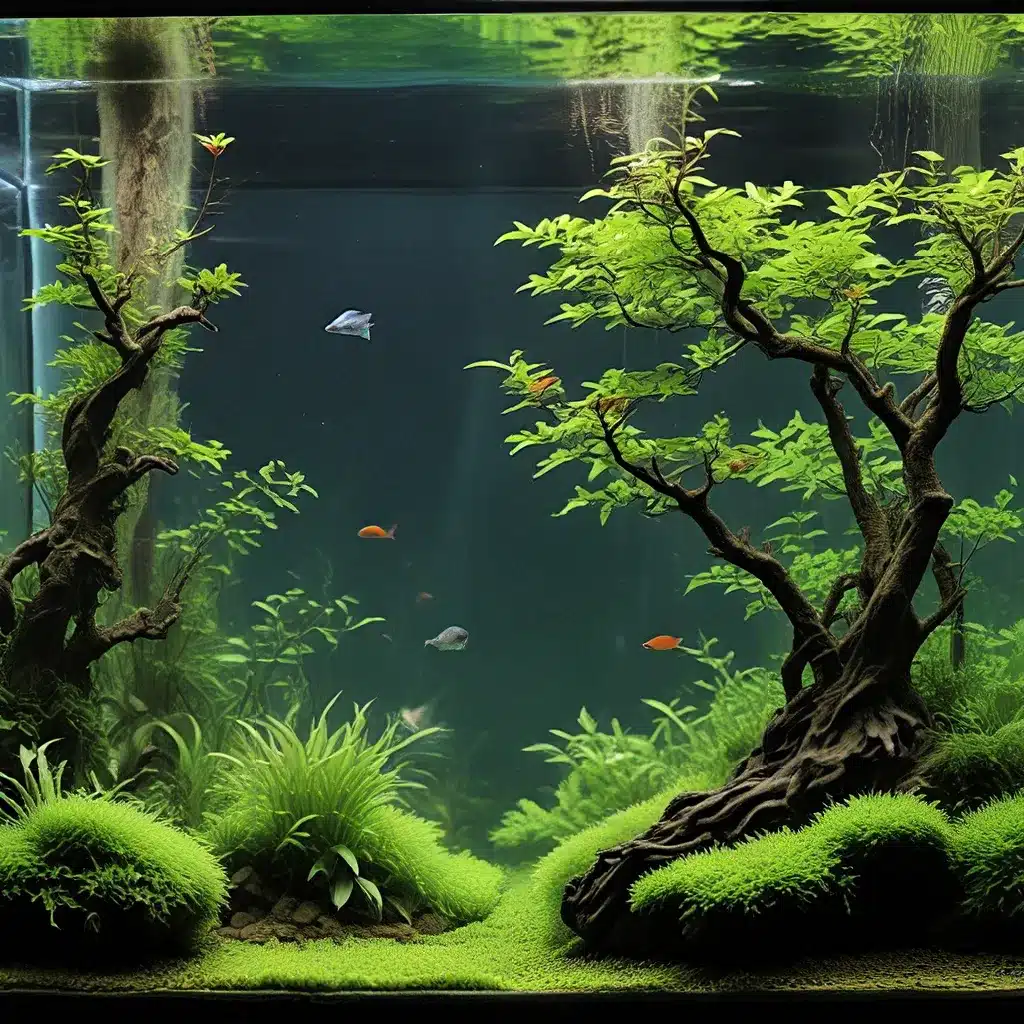
In the captivating world of aquarium keeping, the art of aquascaping has emerged as a true passion for many enthusiasts. This intricate practice of designing and arranging aquatic plants, rocks, and other decorative elements within an underwater landscape has become a key focus for hobbyists seeking to create stunning, nature-inspired environments. As the aquarium hobby continues to evolve, new aquascaping trends are emerging, showcasing the boundless creativity and innovation that aquarists are bringing to their setups.
Embracing Minimalism: The Rise of Iwagumi Aquascapes
One of the most prominent aquascaping trends in recent years has been the Iwagumi style. Originating from the Japanese word for “rock formation,” Iwagumi aquascapes prioritize a minimalist approach, emphasizing the harmonious arrangement of carefully selected stones as the focal point of the composition. These aquascapes often feature a clean, symmetrical layout, with the use of low-growing, carpet-forming plants to create a sense of depth and balance.
The beauty of Iwagumi aquascapes lies in their ability to evoke a serene, natural environment, where the carefully placed rocks take center stage. Aquarists who embrace this style often seek to recreate the tranquility of a Japanese garden or mountain landscape, using the stones as the primary design elements and allowing the plants to accentuate the overall composition.
Innovative aquascape designs in the Iwagumi style have pushed the boundaries of this trend, experimenting with unique rock formations, varying textures, and creative plant placement to create visually striking and thought-provoking underwater landscapes.
Mastering the Art of Iwagumi Aquascaping
Crafting a successful Iwagumi aquascape requires a keen eye for detail and a deep understanding of the interplay between the various elements. Selecting the right stones, considering their size, shape, and placement, is crucial to achieving the desired aesthetic. Equally important is the choice of low-growing, carpeting plants that can thrive in the specific lighting and water conditions of the aquarium.
Experienced aquarists emphasize the importance of balance and symmetry in Iwagumi aquascapes, as these elements contribute to the overall sense of harmony and visual appeal. By carefully arranging the stones and plants, aquarists can create a captivating illusion of depth and perspective, drawing the viewer into the tranquil underwater world.
Embracing Nature’s Chaotic Beauty: Jungle-Style Aquascapes
In contrast to the minimalist approach of Iwagumi, another prominent aquascaping trend has emerged: the Jungle-style aquascape. These aquascapes celebrate the lush, overgrown aesthetic of natural aquatic ecosystems, with a focus on dense plantings, intricate layouts, and a sense of natural chaos.
Jungle-style aquascapes often feature a diverse array of aquatic plants, ranging from tall, vibrant stem plants to leafy, bushy species that create a sense of depth and layering. The placement of the plants is intentionally less structured, mimicking the organic growth patterns found in natural habitats. This approach allows for a more dynamic and unpredictable arrangement, where the plants seem to “take over” the aquarium, creating a visually stunning and immersive underwater landscape.
Innovative aquascaping techniques have further enhanced the Jungle-style aesthetic, with aquarists experimenting with driftwood, rocks, and other aquatic decor to create a sense of depth, texture, and hidden pathways within the dense plant growth.
Mastering the Chaos: Balancing Aesthetics and Functionality
Crafting a successful Jungle-style aquascape requires a delicate balance between aesthetics and functionality. Aquarists must carefully select a diverse range of plant species that can thrive in the specific water parameters and lighting conditions of the aquarium. Additionally, they must consider the growth patterns and maintenance requirements of each plant to ensure the overall composition remains visually appealing and manageable over time.
One key challenge in Jungle-style aquascaping is maintaining the balance between the lush, overgrown appearance and the overall health and vitality of the aquarium inhabitants. Proper water management, nutrient dosing, and regular maintenance are essential to prevent the aquascape from becoming overgrown or compromising the water quality.
Embracing the Future: Innovative Aquascaping Techniques
As the aquarium hobby continues to evolve, aquarists are constantly pushing the boundaries of aquascaping, exploring new techniques and design styles that challenge traditional approaches. From the use of advanced filtration systems to the incorporation of cutting-edge lighting solutions, the world of aquascaping is experiencing a surge of innovation.
One notable trend is the growing emphasis on sustainability and eco-friendly practices in aquascaping. Aquarists are increasingly exploring methods to create self-sustaining, low-maintenance aquarium ecosystems that mimic natural processes, such as the use of nutrient-absorbing plants, efficient filtration, and water recycling systems.
Inspirational aquascaping videos have also played a significant role in the dissemination of new ideas and the sharing of expertise among the aquarium community. Aquarists from around the world are collaborating, exchanging knowledge, and showcasing their innovative setups, fueling the ongoing evolution of aquascaping.
Embracing the Future: Sustainable and Advanced Aquascaping Techniques
As the aquarium hobby continues to evolve, aquarists are embracing a future where sustainability and innovation take center stage. From the use of energy-efficient LED lighting to the incorporation of advanced filtration systems, the pursuit of eco-friendly and low-maintenance aquarium setups has become a driving force in the aquascaping community.
Aquarists are also exploring the potential of automated control systems, which allow for precise management of water parameters, lighting, and even plant growth. These technological advancements not only enhance the aesthetic appeal of the aquascape but also contribute to the overall well-being of the aquarium inhabitants.
Furthermore, the growing interest in community-driven aquascaping has fostered a collaborative environment where aquarists share their experiences, techniques, and inspirations. King Aquarium, for example, has become a hub for aquarists to connect, learn, and celebrate the art of aquascaping, further fueling the innovative spirit of the hobby.
In the ever-evolving world of aquascaping, the future holds endless possibilities. As aquarists continue to push the boundaries of design, technology, and sustainability, the aquarium hobby promises to become an even more captivating and immersive experience for hobbyists, enthusiasts, and nature enthusiasts alike.

